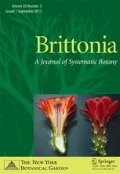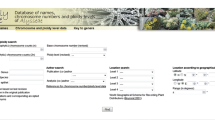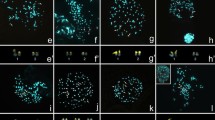Abstract
Chaetogastra is the largest genus in Melastomateae, with about 165–190 species. The genus was only recently resurrected, based on species that have been traditionally treated in Tibouchina sects. Diotanthera, Pseudopterolepis, Purpurella and Simplicicaules. This article presents 15 chromosome counts for the genus, a review of the available counts and also a discussion of these counts in a systematic context. Although the sampling in the genus is still poor, the data found in the literature and in our research indicate x=9 as the base chromosome number for the genus. We also found that euploidy may be common in Chaetogastra, with diploid, tetraploid and hexaploid species. Basic chromosome numbers also seem to be a taxonomic character that distinguishes Chaetogastra (x=9) from Brachyotum (x=10).

Similar content being viewed by others
Change history
11 May 2018
This article was published with an incorrect title. The correct title is: Chromosome counts in Chaetogastra (Melastomataceae, Melastomateae). The original article has been corrected.
Literature cited
Almeda, F. 1977. Systematics of the neotropical genus Centradenia (Melastomataceae). Journal of the Arnold Arboretum. 58: 73–108.
———. 1978. Systematics of the genus Monochaetum (Melastomataceae) in Mexico and Central America. University of California Publications in Botany. 75: 1–134.
———. 1997. Chromosome numbers and their evolutionary significance in some neotropical and paleotropical Melastomataceae. BioLlania Edición Especial 6: 167–190.
———. 2009. Melastomataceae. In: G. Davidse, M. Sousa-Sánchez, S. Knapp & F. Chiang (eds.), Flora Mesoamericana, vol. 4: 164–338. Universidad Nacional Autónoma de México, México City.
———. 2013. Systematic and phylogenetic significance of chromosome number diversity in some Neotropical Melastomataceae. Memoirs of the New York Botanical Garden 108: 155–177.
——— & T. I. Chuang. 1992. Chromosome numbers and their systematic significance in some Mexican Melastomataceae. Systematic Botany17: 583–593.
Alvear, D. M. 2010. Systematics of the genus Monochaetum (Melastomataceae) in Colombia. M.Sc. thesis, San Francisco State University, San Francisco.
Andrada, A. R. & V. A. Páez. 2014. Estudios meióticos y viabilidad del pólen de tres especies de Tibouchina (Melastomataceae). Lilloa 51: 131–140.
Caetano, A. P. S., S. P. Teixeira, E. L. Forni-Martins & S.M. Carmello-Guerreiro. 2013. Pollen insights into apomictic and sexual Miconia (Miconieae, Melastomataceae). International Journal of Plant Sciences 174: 760–768
Cave, M. S. 1964. Index to plant chromosome number for 1963. California Botanical Society, Berkeley
Cogniaux, A. C. 1885. Tibouchina. In: C. F. P. Martius & A. G. Eichler (eds.). Flora Brasiliensis 14(3): 288–418. Typographia Regia, Monachii.
———. 1891. Tibouchina. In: A. Candolle & C. Candolle (eds.). Monographiae Phanerogamarum 7: 197–278. G. Masson, Paris.
CRIA – Centro de Referência em Informação Ambiental. 2016. Species link. http://splink.cria.org.br/ (Accessed 27 November 2016).
Darlington, C. D. & A. P. Wylie. 1955. Chromosome atlas of flowering plants. Allen & Unwin, London.
Fedorov, A. 1974. Chromosome numbers of flowering plants – reprint of first edition. Otto Koeltz Science Publishers, Koenigstein.
Gadella, T. W. J., E. Kliphuis, J. C. Lindeman & E. A. Mennega. 1969. Chromosome number and seedling morphology of some Angiospermae collected in Brazil. Acta Botanica Neerlandica 18: 74–83.
Gill, B. S., S. S. Bir & V. K. Singhal. 1979. In IOPB chromosome number reports LXV. Taxon 28: 630.
Glick, L. & I. Mayrose. 2014. ChromEvol: assessing the pattern of chromosome number evolution and the inference of polyploidy along a phylogeny. Molecular Biology and Evolution 31: 1914–1922.
Goldenberg, R. & G. J. Shepherd. 1998. Studies on the reproductive biology of Melastomataceae in “cerrado” vegetation. Plant Systematics and Evolution 211: 13–29.
——— & I. G. Varassin. 2001. Sistemas reprodutivos de espécies de Melastomataceae da Serra do Japi, Jundiaí, São Paulo, Brasil. Revista Brasileira de Botânica 24: 283–288.
Goldblatt, P. 1984. Index to plant chromosome numbers, 1996–1997. Monographs in Systematic Botany from the Missouri Botanical Garden 8: 1–427.
——— & D. E. Johnson. 1979–2016. Index to plant chromosome numbers. Missouri Botanical Garden, St. Louis. http://www.tropicos.org/Project/IPCN (Accessed 27 November 2016).
Gómez, J. R. S. 2004. Una nueva especie de Tibouchina (Melastomataceae) de Guerrero, Mexico. Novon 14: 163–167.
———. 2012. Tibouchina xochiatencana (Melastomataceae), una nueva espécie de la Sierra Madre del Sur de Guerrero, Mexico. Brittonia 64: 277–281.
Grimm, D. & F. Almeda. 2013. Systematics, phylogeny, and biogeography of Chaetolepis (Melastomataceae). Journal of the Botanical Research Institute of Texas 7: 218–263.
Guerra, M. 1983. O uso de Giemsa em citogenética vegetal: comparação entre a coloração simples e o bandeamento. Ciencia e Cultura 37: 190–193.
———. 2002. Como observar cromossomos: um guia de técnicas. Fundação de Pesquisas Científicas de Ribeirão Preto, Ribeirão Preto.
———. 2008. Chromosome numbers in plant cytotaxonomy: Concepts and implications. Cytogenetic and Genome Research. 120: 339–350.
Guimarães, P. J. F. 2014. Two new species of Tibouchina (Melastomataceae) from Brazil. Novon 23: 42–46.
——— & C. M. S. Oliveira. 2009. Tibouchina. In: M. G. L. Wanderley, G. J. Shepherd, T. S. Melhem & A. M. Giulietti (eds.). Flora fanerogâmica do estado de São Paulo, vol. 6: 127–149. Fapesp, São Paulo.
——— & E. Woodgyer. 2016. A new and unusual amphistomatic species of Tibouchina (Melastomeae, Melastomataceae) from Brazil. Phytotaxa 246: 145–151.
Hunziker, J. H., C. C. Xifreda & A. F. Wulff. 1985. Estudios cromosómicos em angiospermas de Sudamérica. Darwiniana 26: 7–14.
Idárraga, A. & F. A. Michelangeli. 2011. Melastomataceae. In: A. I. Piedahíta, R. C. Ortiz, R. C. Posada & M. Merello (eds.). Flora de Antioquia, Catálogo de las plantas vasculares, vol. 2: 600–626. D’Vinni, Bogotá.
Kobayashi, S. & M. Ono. 1984. A note on Melastoma in the Boni and Volcano Islands. Journal of Japanese Botany 59: 65–70
Mayrose, I., M. S. Barker & S. P. Otto. 2010. Probabilistic models of chromosome number evolution and the inference of polyploidy. Systematic Biology 59: 132–144.
Meenakumari, R. & P. Kuriachan. 1990. SOCGI plant chromosome number reports – X. The Journal of cytology and genetics 25: 321–322.
Meyer, F. S. 2016. Estudos Sistemáticos no clado de Chaetogastra DC. e gêneros aliados (Melastomataceae: Melastomeae). PhD thesis, Universidade Estadual de Campinas, Campinas. Avaliable at: http://www.bibliotecadigital.unicamp.br/document/?code=000968781 (Accessed 10 November 2016).
———, P. J. F. Guimarães & R. Goldenberg. 2010. Tibouchina (Melastomataceae) do estado do Paraná. Rodriguésia 61: 615–638.
——— & R. Goldenberg. 2016. Four new species of Chaetogastra from Southern Brazil. Phytotaxa 282: 239–258.
———, R. Goldenberg & L. J. C. Kollmann. 2016. Three new species of Pleroma (Melastomataceae) from Inselbergs of Espírito Santo, Brazil. Phytotaxa 282: 197–210.
Michelangeli, F. A., P. J. F. Guimarães, D. S. Penneys, F. Almeda & R. Kriebel. 2013. Phylogenetic relationships and distribution of New World Melastomeae (Melastomataceae). Botanical Journal of the Linnean Society 171: 38–60.
Peralta, P. 2002. Las especies del género Tibouchina (Melastomataceae) en Argentina. Darwiniana 40: 107–120.
Renner, S. S. 1999. Melastomataceae. In: P. M. Jørgensen & S. León-Yánez (eds.). Catálogo de las plantas vasculares del Ecuador. Monographs in Systematic Botany from the Missouri Botanical Garden 75: 561–585.
———. 2014. Melastomataceae. In: P. M. Jørgensen, M. H. Nee & S. G. Beck (eds.). Catálogo de las plantas vasculares de Bolivia. Monographs in Systematic Botany from the Missouri Botanical Garden 127: 826–848.
Rice, A., L. Glick, S. Abadi, M. Einhorn, N. M. Kopelman, A. Salman-Minkov, J. Mayzel, O. Chay & I. Mairose. 2014. The Chromosome Counts Database (CCDB) - a community resource of plant chromosome numbers. New Phytologist 206: 19–26.
Rocha, M. J. R., J. A. N. Batista., P. J. F. Guimarães & F. A. Michelangeli. 2016. Phylogenetic relationships in the Marcetia alliance (Melastomeae, Melastomataceae) and implications for generic circumscription. Botanical Journal of Linnean Society 181:585–609.
Schneider, C. A., W. S. Rasband & K. W. Eliceiri. 2012. NIH Image do ImageJ: 25 yeras of image analysis. Nature Methods 9: 671–675.
Solt, M. L. & J. J. Wurdack. 1980. Chromosome numbers in the Melastomataceae. Phytologia 47: 199–220.
Souza, M. L. D. R. 1986. Estudo taxonômico do gênero Tibouchina Aubl. (Melastomataceae) no Rio Grande do Sul, Brasil. Insula 16: 3–108.
Thiers, B. 2017 - continuously updated. Index Herbariorum: A global directory of public herbaria and associated staff. http://sweetgum.nybg.org/science/ih/./ (Accessed 27 June 2017).
Todzia, C. A. & F. Almeda. 1991. A revision of Tibouchina section Lepidotae (Melastomataceae: Tibouchinae). Proceedings of the California Academy of Sciences 47: 175–206.
———. 1999. Ten new species of Tibouchina (Melastomataceae) from Mexico. Brittonia 51: 255–279.
Wurdack, J. J. 1953. A revision of the genus Brachyotum (Tibouchineae-Melastomataceae). Memoirs of the New York Botanical Garden 8: 343–407.
———. 1962. Melastomataceae of Santa Catarina. Sellowia 14: 109–217.
———. 1980. Melastomataceae. In: G. Harling, B. B. Sparre & L. Andersson (eds.). Flora of Ecuador, vol. 13: 1–405. University of Göteborg and Swedish Museum of Natural History, Göteborg and Stockholm.
Acknowledgments
We thank Sandra Maria Carmello Guerreiro for the permission to use the Optic Microscope in the Laboratory of Plant Anatomy at Universidade Estadual de Campinas, Frank Almeda for the assistance with bibliography on chromosome counts of Melastomataceae, and two anonymous reviewers for the suggestions on a previous version of this work.
Author information
Authors and Affiliations
Corresponding author
Additional information
This article was published with an incorrect title. The correct title is: Chromosome counts in Chaetogastra (Melastomataceae, Melastomateae). The original article has been corrected.
Rights and permissions
About this article
Cite this article
Meyer, F.S., Braga, K.R., Forni-Martins, E.R. et al. Chromosome counts in Chaetogastra (Melastomataceae, Melastomateae). Brittonia 70, 369–376 (2018). https://doi.org/10.1007/s12228-018-9522-8
Published:
Issue Date:
DOI: https://doi.org/10.1007/s12228-018-9522-8




